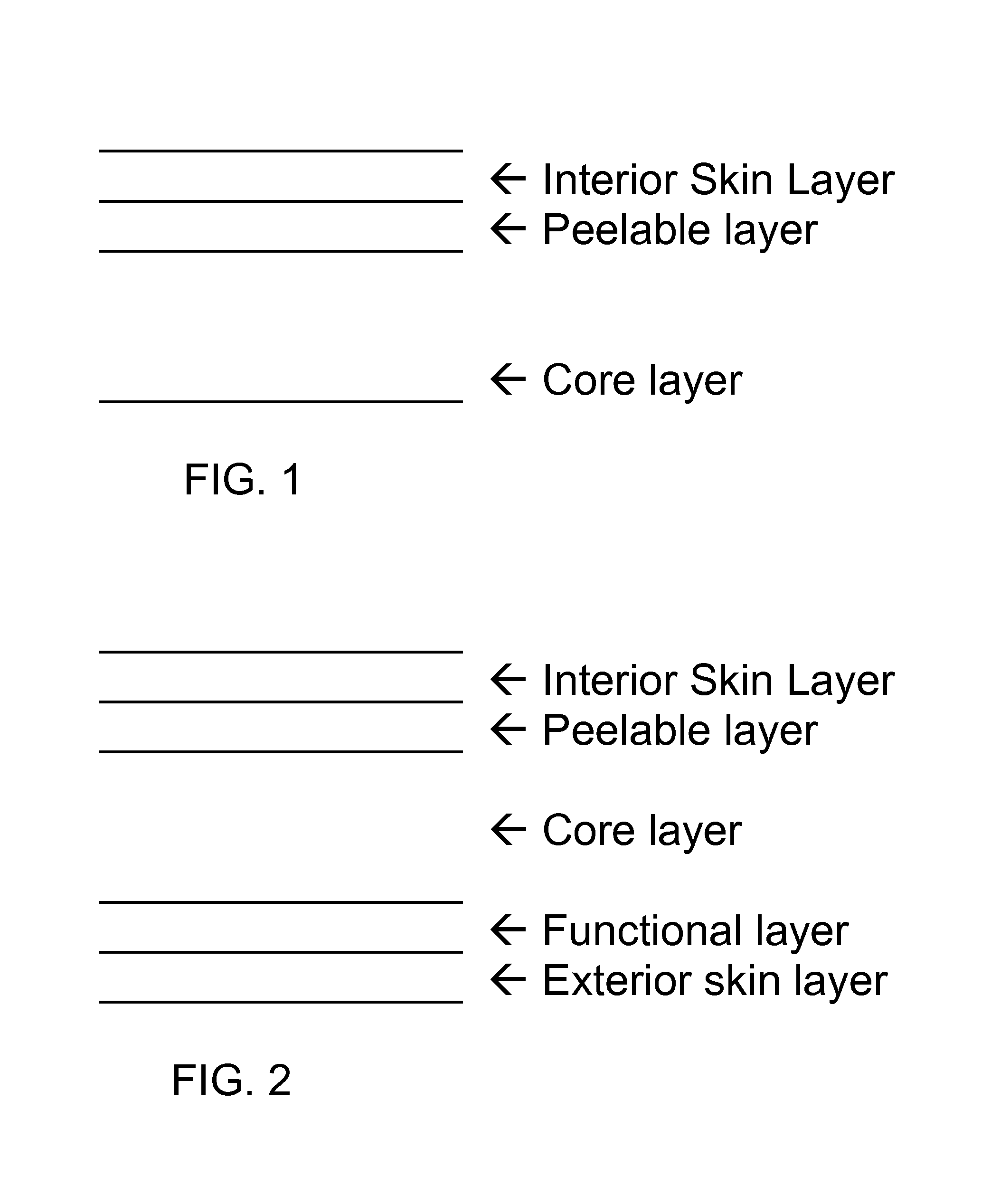Peelable, non-sticky, heat-sealable film for packaging fatty and pasty foods
a film, non-sticky technology, applied in the direction of packaging foodstuffs, packaged goods, synthetic resin layered products, etc., can solve the problems of packaging being opened more quickly and/or more completely than before, and requiring a correspondingly high force to separate the joined layers
- Summary
- Abstract
- Description
- Claims
- Application Information
AI Technical Summary
Problems solved by technology
Method used
Image
Examples
example 1
[0026]A peelable cheese film was prepared with an interior skin layer, peelable layer, and core layer having thicknesses of 1.0, 1.0 and 19 μm, respectively. On the other side of the core layer there were a functional layer of polypropylene and additives, and an exterior skin layer of a polyolefin of low seal initiation temperature and additives, as generally depicted in FIG. 2, each having a thickness of about 1 μm. The interior skin layer had 30,000 ppm GMS release agent blended into an ethylene-propylene-butene-1 terpolymer comprising 2 wt % ethylene, 88 wt % propylene, and 10 wt % butene-1. The peelable layer was polypropylene homopolymer with a loading of peeling agent EAA of 30%. The core layer was polypropylene homopolymer with a GMS loading of 6000 ppm. There was no release agent GMS in the peelable layer. The release properties were not satisfactory.
example 2
[0027]A second peelable cheese film was formed with an interior skin layer, peelable layer, and core layer having thicknesses of 0.7, 1.0 and 18.8 μm. The loading of peeling agent EEA in the peelable layer was reduced to 20%, with a balance of polypropylene homopolymer. On the other side of the core layer there were a functional layer of polypropylene and additives of 1 μm thickness, and an exterior skin layer of a polyolefin of low seal initiation temperature and additives of 1.5 μm, as generally depicted in FIG. 2. The loadings of release agent GMS in the skin layer and core layer were 45,000 and 8,000 ppm, respectively. Otherwise, the materials were the same as in Example 1. The release agent loading (Rc) in core layer fell within the range of 5,300-16,000 ppm according to the equation 0.5×Tp×(Pp / Tc)
example 3
[0028]A third film (XE-449) was formed with an interior skin layer, peelable layer, and core layer having thicknesses of 0.7, 0.7 and 19.6 μm. The loading of peeling agent EEA in the peelable layer was 30% (with a balance of propylene homopolymer) and the thickness of the peelable layer was lower (0.7 μm). On the other side of the core layer there were a functional layer of polypropylene and additives, and an exterior skin layer of a polyolefin of low seal initiation temperature and additives, as generally depicted in FIG. 2. The release agent GMS loadings in the skin layer and core layer were 45,000 and 8,000 ppm, respectively. Otherwise, the materials were the same as in Example 1. The release agent GMS loading in the core layer was within the range of 5,380-15,800 ppm per the equation in item 1. The release properties were satisfactory.
[0029]As shown in Table 1, the release properties were not satisfactory when the concentration of release agent in the core layer was not greater ...
PUM
| Property | Measurement | Unit |
|---|---|---|
| thickness | aaaaa | aaaaa |
| thickness | aaaaa | aaaaa |
| thickness | aaaaa | aaaaa |
Abstract
Description
Claims
Application Information
 Login to view more
Login to view more - R&D Engineer
- R&D Manager
- IP Professional
- Industry Leading Data Capabilities
- Powerful AI technology
- Patent DNA Extraction
Browse by: Latest US Patents, China's latest patents, Technical Efficacy Thesaurus, Application Domain, Technology Topic.
© 2024 PatSnap. All rights reserved.Legal|Privacy policy|Modern Slavery Act Transparency Statement|Sitemap

